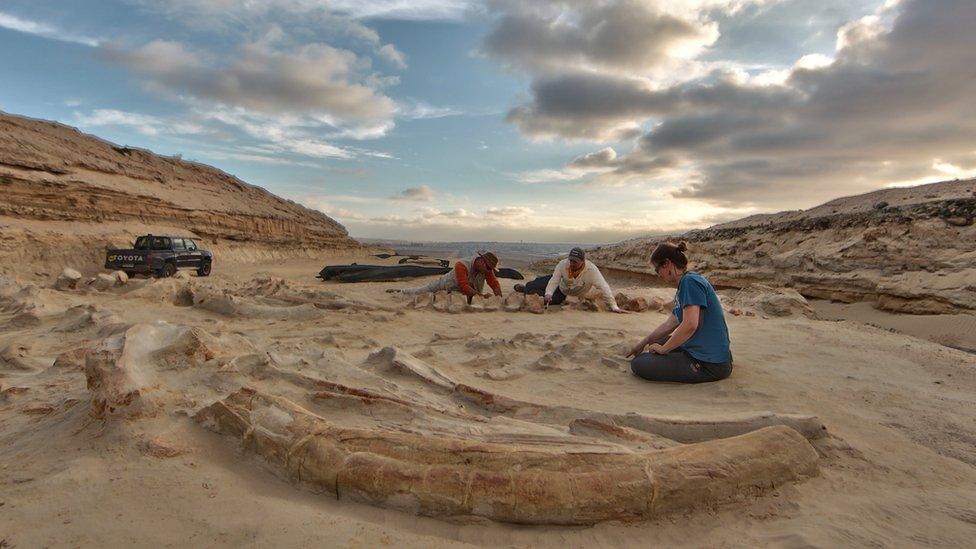White fossil was 'Moby Dick' of the ancient sea
- Published
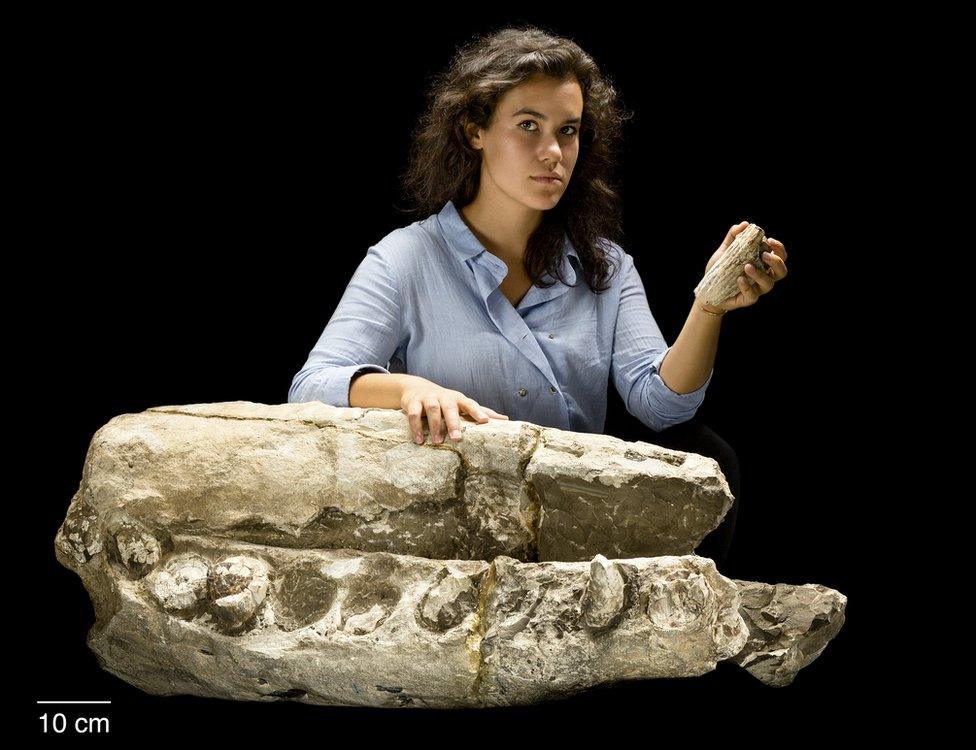
Alex Boersma with the reclassified Albicetus specimen
In Hollywood's version of the events that inspired the classic novel Moby Dick, a giant sperm whale terrorises the crew of a whaling ship and eventually destroys the vessel.
Based on the true story of the sinking of the Essex in 1820, the film, In the Heart of the Sea, portrays the whale as a merciless monster that pushes its shipwrecked victims to the brink of madness.
Did such a terrifying creature ever exist? Scientists at the Smithsonian Institution say it probably did - but 15 million years ago.
They've identified an ancient genus of sperm whale that, unlike its modern cousins, had enormous teeth.
"Modern sperm whales only have teeth in their lower jaw, partly because their main food source is squid," says Alex Boersma, lead author of the new research published in the open access journal PLoS One, external.
"To see a fossil sperm whale like ours that has these big prominent teeth in both the lower and upper jaws suggests they were feeding on something very different - possibly other marine animals."
The fossil was part of a collection amassed in the 1920s by Remington Kellogg, a palaeontologist who helped introduce protections for whales and became the first chairman of the International Whaling Commission.
The specimen was placed in the vast stores of the Smithsonian's National Museum of Natural History, external in Washington where staff noticed that the label was incorrect. It said the bones belonged to an extinct walrus instead of a sperm whale.
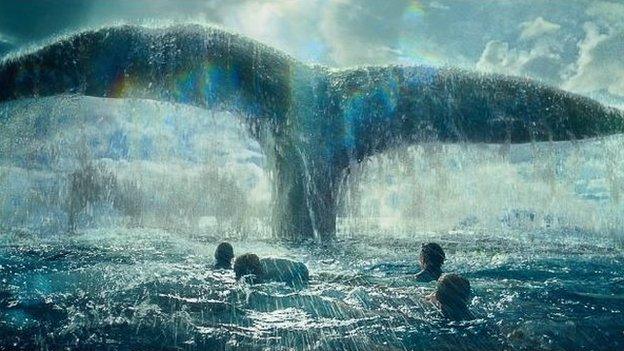
The myth depicted in the new Hollywood movie In the Heart of the Sea
Confusion reigned until 90 years later when Nick Pyenson, the curator of fossil marine mammals, external and research co-author, decided to take another look.
But examining the fossil posed its own problems. It weighed around 300 pounds (140kg) and was thoroughly encased in rock.
"We could see places where people had tried to excavate the bone and where it had gone wrong because it's very hard to do," says Pyenson. Fortunately, a relatively recent tool to science made things easier.
The fossil was scanned using lasers and the 3D data taken from the surface enabled the two scientists to study detailed digital models that could be rotated without having to move the rock itself.
"This specimen is huge and the first time we rolled it over to see the underside, it took four people and we sacrificed a couple of fingers," says Boersma. "Having that 3D model was crucial, external."
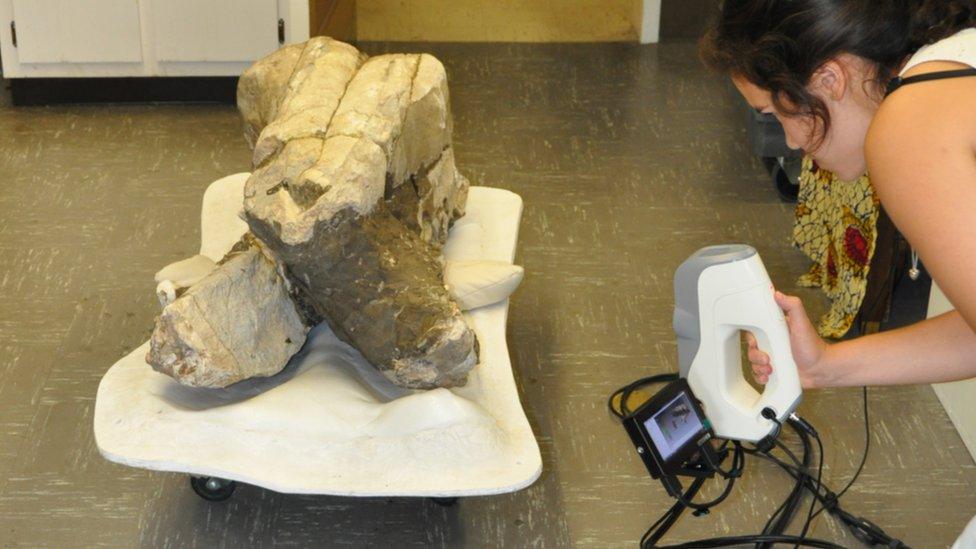
Using a scanner to collect 3D data of the Albicetus specimen
It was also critical to establishing the fact that the fossil contained upper teeth.
"The discovery was pretty late on in the process and we had already written most of the manuscript," says Boersma. "We were looking at the computer model and talking over the phone and Nick said, 'I think it has upper teeth'.
"We had to re-evaluate our paper which was exciting and stressful at the same time because it opened up our research to new possibilities and was the moment we realised that this whale was different to anything else in the fossil records."
And although the fossil was incomplete and fragmented, the 3D models also helped Boersma create artistic impressions of what it may have looked like in the flesh.
"This is where art meets science," says Pyenson. "3D lets you be creative and work with the resources you have in a very powerful way."
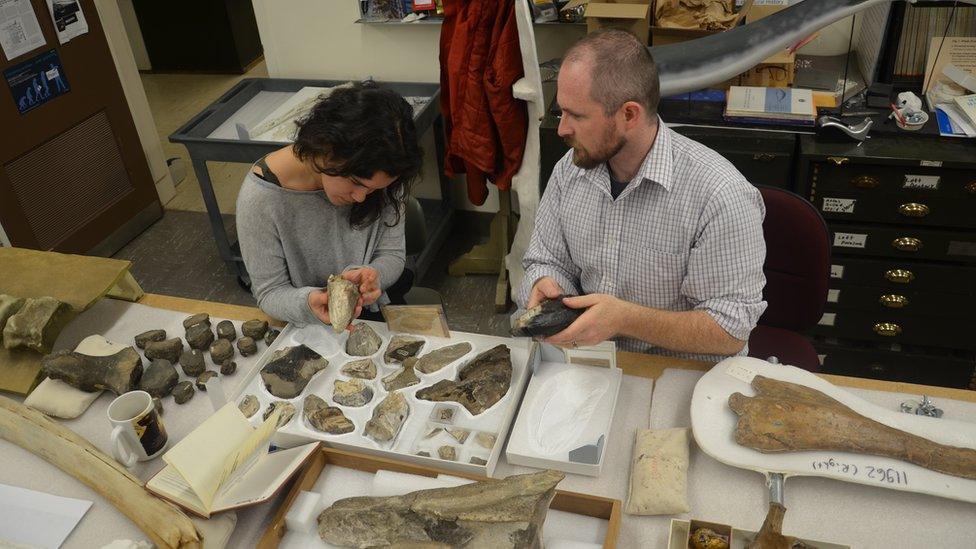
Assessing fossils involves comparisons between different specimens
The fossil whale is about 6m long - much smaller than modern sperm whales which can reach 16m in length. It also lacks the characteristic block-shaped head of today's sperm whales which contains wax and most likely enhances their ability to use sonar to hunt prey.
The physical differences show how sperm whales have evolved. Those changes are further evidence that the ocean itself was a very different environment, probably much more richly populated than it is today.
"Fifteen million years ago, when our specimen was roaming the seas, there was a large number and large diversity of other marine mammals swimming around. These marine mammals could have been providing our whale - and others - with food," says Boersma.
Hence the teeth. But was the ancient whale really a monster of the deep?
"I definitely think this whale is pretty fierce and ate its fair share of marine mammals. But when we think about Moby Dick and hear stories about sperm whales ferociously attacking humans - that's not actually something we see in the wild," the scientist says.
"Even killer whales that have been known to attack and kill humans in captivity - to my knowledge, there's no record of them attacking humans in the wild."
And Nick Pyenson adds: "He might have whacked you with his tail, but it's less likely he would have taken a chunk out of your leg. They were still whales and just because they're 15 million years old doesn't mean they weren't very intelligent and pretty social - if their living descendants are any example."
Nevertheless, inspired by the fossil's bone colour the scientists have named their new genus Albicetus meaning "white whale", or more affectionately, Moby Dick.
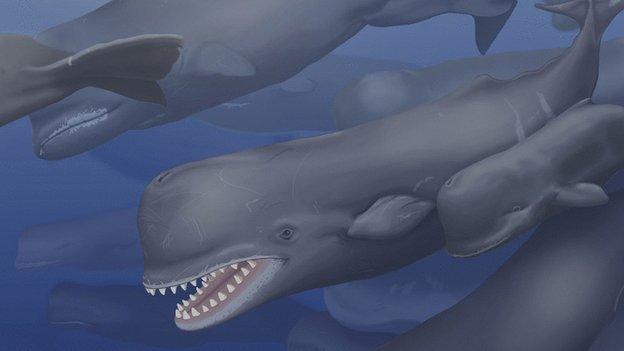
An artist's impression of the toothed whale
- Published26 February 2014
